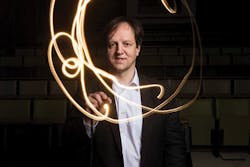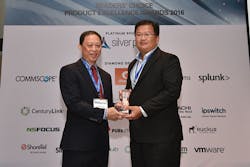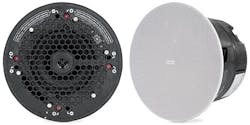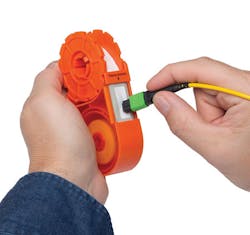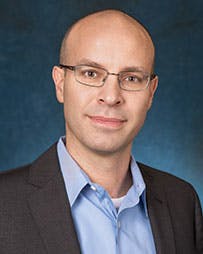Editor's Picks
Light fidelity (LiFi) technology transmits data through light, turns lamps into wireless Internet access points
Professor Harald Haas, CSO of pureLiFi and Professor of Mobile Communications at the University of Edinburgh, received the International Solid State Lighting Alliance (ISA) Award for Outstanding Achievement in Beijing, China this past November. The award, presented at the 13th International Forum on Solid State Lighting, relates to Professor Haas’s contribution to diversify the applications of solid state lighting (SSL) technology. According to the forum, “LiFi, which stands for ‘light fidelity’, is a technology that can transmit data through light and turn the lamps in every office, home, car or streetlight into wireless Internet access points. It offers higher speeds than traditional wireless technology, greater security and the potential to deliver unprecedented bandwidth and data density.” 2014 Nobel Prize for Physics winner and previous winner of the Outstanding Achievement, Professor Shuji Nakamura, presented Professor Haas with the award.
Professor Haas was recognized as the "father of LiFi" after introducing the technology to the world at a TED Global talk in 2011, where he demonstrated light fidelity for the first time and coined the term LiFi. The company he founded in 2012, pureLiFi, is at the forefront of the commercialization of LiFi technology, and in 2016 launched the world’s first LiFi dongle-“LiFi-X”-and integrated LiFi luminaire. A statement from the ISA jury presenting the award noted that “[Professor Haas] not only pioneered the novel concept of communication by lighting devices, but also publicized the technology earning him the recognition as the ‘father of LiFi’. The technique based upon SSL devices is penetrating the market of indoor ICT and certainly will have a great future in the era of Internet of Things. This is a considerable contribution to diversify the applications of SSL technology and open up new markets. His scientific-technical achievement certainly deserves to be awarded.”
Haas established the world’s first LiFi center in 2013, when the LiFi Research & Development Center opened at the University of Edinburgh. The center now leads cutting-edge R&D, including pioneering work into the use of solar panels as receivers, in a move which Haas says could help tackle Internet access problems in the developing world-the so-called "digital divide." Professor Haas said about the significance of receiving the commendation, “It has been such a great honor to receive this prestigious award, which I would like to devote to everyone who supported me on this 14-year journey. LiFi is like an undiscovered beach full of pebble stones-under each stone there is something new and exciting to discover, and what is really thrilling is that these discoveries can change our lives and create massive commercial opportunities.”
Anixter opening new flagship facility in Houston, TX
On October 7, 2016 Anixter International Inc. announced that it would be opening a customized Houston, TX flagship facility in Jersey Village, located near the city’s Beltway 8 and 290 interchange areas.
Scheduled to open in early 2017, the new 200,000 sq. ft. Anixter location will enable the company to stock a comprehensive product portfolio spanning across electrical, data and security solutions, and will showcase its full range of value-added services. In addition to the warehouse facility, a team of on-site sales and technical experts will be available to help customers with product, technology and solution questions covering electrical, electronic, data, enterprise and security applications.
The new location is also being designed to include a “Solutions Briefing Center”, where customers can receive hands-on product evaluation and training and engage with technical specialists for product and solution selection.
Chris Blakeslee, Anixter’s North American SVP-Electrical and Electronic Solutions (EES), commented, “Our new location in Houston will allow us to fully execute our value proposition for customers in the Houston market. Our range of products, covering every aspect of electrical, data, and security installations is the broadest in the industry, and will result in a true one-stop shopping experience. It also represents our continued enthusiasm and commitment to our suppliers and customers.”
“To collocate with our EES salespeople will create an environment that makes it easier to provide our customers with broader value and more relevant business solutions,” added Dirk Naylor, North American SVP-Network and Security Solutions, Anixter. “Hosting all of the resources for customer support in one location will make Anixter a more effective business partner in the Houston marketplace, and will allow our customers to better leverage our supply chain solutions and technical expertise,” added Naylor.
Anixter, which acquired the Houston-area locations of HD Supply-Power Solutions Division in October 2015, has also announced the appointment of a new senior business leader for the Houston market. Greg Roth, formerly regional vice president for Anixter’s EES business in central Florida, brings 25 years of electrical wholesale distribution experience. Roth will immediately assume the role of vice president of sales for the distributor’s Houston-area Electrical and Electronic Solutions’ business.
Panduit named best ‘Data Center Cabling Solution’ by NetworkWorld Asia’s Reader’s Choice awards
Panduit Corp. was recently honored to receive the Reader’s Choice Product Excellence Award from NetworkWorld Asia magazine and Networksasia.net for the company’s “Data Center Cabling Solutions.” The award was announced last October 29th in Singapore.
NetworkWorld’s Reader’s Choice Award is in its 12th year, and is based on votes received through NetworkWorld Asia magazine, as well as the Networks Asia, Security Asia, Storage Asia and Asia Cloud Forum websites. Award criteria included: reputation of vendor in the marketplace; features and unique selling proposition (USP) of the solution; widespread acceptance of technology and/or brand; users’ feedback on the solution/deployment; as well as platform durability, scalability and quality of service, as contributing factors.
“For over 60 years, Panduit has been recognized as a leading brand for our high quality, innovative and reliable infrastructure solutions which solve our customers’ real world challenges,” commented Thomas Poh, Panduit’s director of marketing for the APAC region (pictured, right). “This award is an endorsement from our customers of the kind of experience they have come to expect from Panduit. We are honored and will continue to work hard to maintain this trust.”
ZigBee-based occupancy sensor, smart outlet reference designs foretell IoT-connected smart homes
Silicon Labs has released wireless occupancy sensor and smart outlet reference designs for the home automation market, outlining IoT (Internet of Things) connected device solutions projected to help make homes safer, as well as more convenient and energy efficient.
The FCC and UL precertified reference designs include all of the hardware, firmware and software tools required to create feature-rich, futureproofed connected home products based on Silicon Labs’ robust ZigBee “Golden Unit” Home Automation (HA 1.2) software stack and multiprotocol Wireless Gecko system-on-chip (SoC) portfolio. Silicon Labs says the occupancy sensor and smart outlet reference designs will help home automation device makers and developers accelerate time-to-market and reduce system cost and complexity via best-in-class ZigBee mesh networking technology. By leveraging the turnkey reference designs, developers can quickly advance from design concept to final product with precertified wireless technology, open-source hardware design files and industry-standard software stacks, while also taking advantage of proven test setups and manufacturing methods.
“Successful home and building automation products must be standards-based, cost-effective, easy to deploy by end users, and designed to work in real-world environments and solve specific problems with minimal design complexity,” said Daniel Cooley, senior vice president and general manager of Silicon Labs’ IoT products. “We’re helping connected home developers achieve these market-critical objectives with precertified reference designs based on our breakthrough multiprotocol wireless and sensing technologies.”
The occupancy sensor reference design is a compact, precertified ZigBee HA 1.2 solution featuring a wirelessly connected passive infrared sensor along with ambient light and temperature/relative humidity sensors from Silicon Labs.
Occupancy sensors are key components for residential and commercial security systems, as well as other home/building automation systems that use occupancy detection to automate tasks such as turning lights off and on. The occupancy sensor’s small, battery-powered design (the size of two AAA batteries) is so energy efficient it can operate for up to five years before battery replacement. The sensor’s detection range extends up to 12 meters (nearly 40 feet) with a 90-degree viewing window.
The smart outlet reference design is a complete, precertified solution for a wirelessly controlled outlet plug that can be used to power and control a wide range of home and building automation products. Powered by an AC main-voltage line, the smart outlet communicates wirelessly to ZigBee mesh networks. The smart outlet design includes the following key features: built-in diagnostics and metering with a user-friendly web interface for wireless control and current/voltage monitoring, easily accessible from mobile devices; a wide AC voltage range (110-240 V) for global use along with a 15 A load current; integrated high-accuracy sensors for measuring ambient light and temperature/humidity; and compact design footprint of 6.5 cm x 6.5 cm x 4.0 cm.
Graybar appoints new Seattle district VP
Graybar, a North American distributor of electrical, communications and data networking products and a provider of related supply chain management and logistics services, has appointed Stephen Cray as its district vice president in Seattle, effective January 1, 2017.
Cray will replace Kirk Snure, who retired as district vice president after more than 31 years with the distributor. Graybar’s Seattle district is one of 13 operating districts for the employee-owned company, serving customers throughout Washington, Oregon, Idaho, Montana, Alaska and Hawaii. In total, the district includes 12 locations and more than 430 employees. Cray has 30 years of experience in the electrical industry and has been with Graybar for more than a decade. He currently serves as director, electrical sales in the company’s Southern California region, a position he has held since 2008.
“We thank Kirk Snure for his leadership, dedication and service to Graybar and wish him all the best in retirement,” said David Maxwell, Graybar’s regional vice president. “We also congratulate Steve Cray on his appointment to Seattle district vice president. He brings extensive experience to this assignment and we are confident in his ability to lead our business in this region. I look forward to working with him as he takes on this new role.”
Massive Ashburn, VA data center campus on 76.5 acre site to accommodate 6 buildings
RagingWire Data Centers, a U.S. data center provider, and its parent company NTT Communications (NTT Com), the ICT solutions and international communications business within the publicly traded NTT Group, announced that the company is investing $160 million to build the new Ashburn VA3 Data Center in the heart of the famed "Data Center Alley" in Ashburn, Virginia, widely cited as the top data center market in the world.
The Ashburn VA3 Data Center represents phase one of RagingWire’s massive Ashburn Data Center Campus development, which can accommodate six buildings on the 76.5-acre site. The VA3 Data Center with 245,000 square feet of space and 16 megawatts of power is scheduled to be available by the end of 2017. RagingWire and NTT Communications made the announcement of the new facility at the 2016 Gartner Data Center, Infrastructure, and Operations Management Conference, held in Las Vegas last December 5-8. Last year was RagingWire’s fifth as a sponsor of the Gartner conference.
According to a press release, “The VA3 Data Center will realize new levels of availability, flexibility and global reach. The facility features a new flexible electrical design that builds on RagingWire’s patented and award-winning 2N+2TM power delivery architecture to offer wholesale customers that purchase an entire vault the option of dedicated electrical solutions including N+1 and 2N. Vaults will be available in increments of two to four megawatts, and there will be space and power available for multi-rack cages that can grow over time. The campus will have three diverse fiber entrances, reliable and cost-effective utility power from Dominion Virginia Power, a high-security gated entrance and anti-climb perimeter fence, and world-class customer amenities including lounges, breakrooms, a game room, a gym, locker rooms and showers, conference rooms, and office space. VA3 will also offer extensive, carrier-neutral network connectivity services to other data centers and cloud providers.”
“The Ashburn VA3 Data Center raises the bar for data center colocation in the largest data center market in the world,” said George Macricostas, chairman, CEO and founder of RagingWire Data Centers. “VA3 offers mission-critical performance, flexible configurations for hyperscale cloud and enterprise deployments, exceptional customer amenities, and global integration with NTT Com’s growing portfolio of over 140 data centers around the world.”
The VA3 Data Center joins RagingWire’s VA1 and VA2 data centers, which also are in Ashburn. The company notes that the combination of VA1, VA2 and VA3 creates a data center footprint of more than a half million square feet of space and 44.4 megawatts of power, and includes on-site security officers and multi-layered security systems, highly efficient cooling and carrier-neutral telecommunications, and direct connectivity to top cloud providers and other data centers in Data Center Alley. On a wider scale, VA3 will grow RagingWire’s existing 1.2-million-square-foot U.S. data center platform, which includes CA1, CA2, and CA3 in Northern California and TX1 in Dallas, TX, as well as NTT Com’s global data center services platform operated under the Nexcenter brand.
Two-way ceiling speaker approved for plenum spaces
Extron Electronics recently introduced the SoundField XD model SF 26CT, a 6.5-inch two-way ceiling speaker that features an 8-inch-deep composite backcan for use in plenum-rated ceiling environments. The driver complement includes a 6.5-inch woofer coupled with a 0.75-inch ferrofluid-cooled dome tweeter.
“With the AV industry’s first UL 2043-listed composite speaker enclosure, the SF 26CT meets stringent UL requirements for smoke and heat release in plenum air spaces,” Extron said when introducing the speaker in January. “A magnetically attached grille with a thin-edged bezel gives the SF 26CT a refined appearance on the ceiling. The SF 26CT offers both direct 8-ohm and 70/100-volt operation with a behind-the-grille, six position power selector switch. With 70/100 volt taps at 8, 16, 32 and 64 watts, the SF 26CT can be used in applications where a high-power distributed speaker system is needed.”
Casey Hall, vice president of sales and marketing for Extron, commented, “The SF 26CT represents a new level of quality and innovation in speaker design. With excellent performance and features that simplify installation, the SF 26CT is ideal for use in applications that require both vocal clarity and musical accuracy.”
Extron says that SoundField XD speakers are designed with integrators in mind; they are constructed using a two-piece modular design with a separable backcan and baffle, which the company says simplifies installation in both single-trade and division-of-labor installations. “These speakers include a cable/conduit access plate that can be oriented as side mount, for low-clearance ceilings, or as top mount for blind-mounting into drywall ceilings,” Extron added. “Opti-Torque indicator rings provide a visual indication when the locking arm screws have been sufficiently tightened, preventing damage to the speaker caused by over-torqueing.” The speakers are sold in pairs.
Patented RF technology monitors wireless signals in the home for ‘camera-less’ security
At the 2017 Consumer Electronics Show (CES) in Las Vegas, Cognitive Systems Corp., an RF technology specialist, announced the launch of Aura, an intelligent home security system that uses the company’s patented spectrum analytics technology to detect and monitor motion. The patented technology is used to monitor the disruption of wireless signals caused by movement in the home, without the use of cameras.
The simple, two-piece Aura system provides full coverage for the average home, even in rooms where people are typically unwilling to place cameras. Household members are notified on their smartphones of unauthorized motion that occurs anywhere in the residence. The Aura system can also recognize the presence of known household members, show motion patterns in the home, provide a timeline of activity, deliver tailored notifications to homeowners’ smartphones, and interact with other smart home systems.
“When we realized that our technology could understand motion by seeing how the patterns in wireless signals change in a home, we knew that we had something special,” said Taj Manku, cofounder of Cognitive Systems. “By using radio frequencies to detect motion, we provide a more dependable solution to consumers by eliminating most of the false detections that occur with traditional sensors. We thought about how people want to interact with their security system and provide convenient features like auto-arm and disarm. We’re excited to be launching Aura at CES, and looking forward to shipping by the end of February 2017.”
Aura is powered by a custom chipset from Cognitive Systems that monitors and analyzes wireless signal patterns that occur when movement takes place within a home, and alerts the user if unauthorized motion is detected. The company says its Aura system is more accurate than other motion detectors, because the system is not dependent on light and it understands the difference between human and non-human movement (e.g. a fan, shadows, drapes blowing, etc.). Aura will be launching with IFTTT integration so it can connect with other smart home systems as desired.
The Aura system is set-up and managed via a free app available in the Apple App Store and on Google Play. The app allows homeowners to see three different views of motion for Live, 12 Hour and Weekly. Consumers can also use the app to see who is currently at home, a timeline of household activity, arm or disarm the system and more.
IEEE publishes 802.1Qbz bridged networks amendment
IEEE and the IEEE Standards Association (IEEE-SA) recently announced the availability of the IEEE 802.1Qbz Standard for Local and Metropolitan Area Networks-Bridges and Bridged Networks Amendment: Enhancements to Bridging of IEEE 802.11 Media. The new standard specifies protocols, procedures, and managed objects for IEEE 802.11 media to provide internal connections within bridged networks, as well as access to bridged networks.
According to the IEEE-SA, “A number of new products, including home entertainment systems and industrial control equipment, are enabled with both IEEE 802.11 wireless station capability and wired IEEE 802.3 Ethernet capability. IEEE 802.1Qbz meets a growing demand to incorporate IEEE 802.11 media at the same level as other media supported by bridges, both as a medium internal to the network and as a medium offering access to the network.”
IEEE 802.1Qbz is available for purchase at the IEEE Standards Store.
“IEEE 802.1Qbz demonstrates our commitment to stay abreast of industry needs and respond quickly to ensure technology standards continue to meet evolving networking challenges,” said Norm Finn, editor of IEEE 802.1Qbz. “Enabling IEEE 802.11 on par with other media within bridged networks offers greater and more flexible options for overcoming connectivity issues and ensuring the highest degree of reliability for devices operating on a network.”
Ideal Networks offers guidance on Tier-1 and Tier-2 fiber-optic testing
To help cable installers and maintenance technicians select the correct fiber-optic testing equipment for their deployments, Ideal Networks recently published a free technical white paper that offers guidance on the different tiers for certifying fiber-optic cabling.
“Unlike copper cabling, there are two tiers available when certifying fiber-optic cabling, and these dictate which type of tests must be performed, and therefore which testers should be used,” notes Dan Payerle, business unit manager for Ideal Networks. “To remove confusion around which type of test should be used - and whether performing Tier-2 certification also meets the requirements of Tier-1 certification - the new white paper clarifies the different requirements in detail, as well as looking at the advantages of different testers and how they work.”
Briefly, as explained by the company, Tier-1 certification is a measurement of the total insertion loss (or attenuation) of cabling from one end of the link to the other, and either uses an optical power meter and optical light source (PM/LS) or an optical loss test set (OLTS) for testing.
Tier-2 certification provides loss information about each component of the link and uses an OTDR (optical time domain reflectometer) to perform certification, providing a useful graphical representation of each connection, splice and cable segment in the link, and their performance.
When certification is required, the guide recommends that “it is good practice to perform a Tier-1 test, and optionally conduct a Tier-2 test. Although an OTDR can show the total link loss like an OLTS does, Tier-2 certification cannot replace Tier-1 certification, as there is a subtle distinction between the total link loss reported by the two devices.”
The white paper further advises, “An OLTS, such as the Ideal Networks OC I Tier-1 fiber cable certifier, measures the true optical loss of the link, which makes it the most accurate way to determine end-to-end loss of a link and a requirement for Tier-1 certification. However, an OTDR, like the OTDR II from Ideal Networks, characterizes the link under test and can offer additional advantages, such as advanced troubleshooting for faster repairs.”
“Ultimately the required testing is an agreement between the cabling contractor and their customer,” concludes Ideal’s Payerle. “However, in order to provide customer satisfaction, it is essential that fiber-optic installers understand the different tiers and therefore which certification reports will provide the necessary assurance.”
Corning receives Technology and Engineering Emmy Award
At the 68th Annual Technology and Engineering Emmy Awards, held in conjunction with the Consumer Electronics Show in Las Vegas, NV, Corning Incorporated received an award for its 1970 invention of low-loss optical fiber. “The award honors breakthrough innovations that materially affected television engineering,” Corning said in an announcement after receiving the award. Corning received the award in the category of Pioneering Invention and Deployment of Fiber Optic Cable.
Corning’s executive vice president Clark Kinlin stated, “The ability to view high-quality video at any time of the day, from almost any place on a variety of connected and mobile devices, is commonplace today. But it would not be possible without the broad deployment of optical fiber. It’s impossible to imagine the television industry today without the virtually limitless bandwidth capability of optical fiber. It was born in Corning labs in 1970, and our scientists haven’t stopped improving it since.”
The company recalled that scientists Drs. Robert Maurer, Donald Keck and Peter Schultz developed the first low-loss optical fiber capable of maintaining the strength of laser light signals over significant distances. This breakthrough, Corning added, helped solve the problem network carriers faced at the time in handling the growing volume of information with the transmission limitations of copper lines.
Kinlin concluded, “As we envisioned in our ‘A Day Made of Glass’ videos, our portfolio of glass products both redefine the simplest of today’s activities and make new things possible. We’re grateful to be recognized by The National Academy of Television Arts and Sciences and, just as we’ve always done, we remain committed to bringing glass-related innovations to the continuously evolving communications and entertainment industries.”
Alternative to trigger-operated fiber endface cleaning tools
MicroCare Corporation introduced the Sticklers brand Cassette CleanClicker at the BICSI Winter Conference and Exhibition, which took place January 23-26. “The cassette cleaner is designed to be an economical alternative to more-expensive, trigger-operated cassette cleaners,” the company said. The Cassette CleanClicker uses a high-performance microwoven fabric for the cleaning ribbon, which has high absorbency for removing endface contamination, the company explained. “The woven material provides excellent dust-trap capabilities,” MicroCare added about its new fiber endface cleaning tool.
It can be used either as a dry wipe or as part of a wet/dry cleaning process, MicroCare noted. It cleans all female MPO connectors of any fiber count, as well as standard single and duplex fiber connector assemblies. “This makes it ideal for field installations, test labs, OEM equipment and cable assembly production, field installers and installation kits,” the company added.
MicroCare describes the Cassette CleanClicker endface cleaning tool as disposable in a translucent housing. The device is unique in that it features manual, user control of the cleaning ribbon. “This enables the operator to perform multiple cleanings on the same piece of ribbon, which reduces cleaning costs,” the company said. “The translucent plastic housing also makes it easy for the operator to visually judge the quantity of cleaning ribbon remaining in the cassette, avoiding unpleasant surprises out in the field.”
It also features a shutterless cleaning window. MicroCare declared, “Traditional, more-expensive cassette cleaners use a shutter mechanism in an ineffective attempt to protect the cleaning ribbon. These tools also require a complex, spring-loaded trigger mechanism to advance the cleaning ribbon and open the shutter to expose the cleaning ribbon. These features also make those tools more expensive so companies refill them, which adds even more costs and logistical worries. All of this over-engineered complexity is not necessary since it does not protect the cleaning ribbon from moisture or dust. The new Sticklers Cassette CleanClicker tool avoids all these problems and costs without sacrificing performance.”
Analyst: 145 cloud and colo companies account for 40 percent of global data center space
The top 145 cloud and colocation companies are now estimated to account for 40 percent of global data center space, measured in square footage, according to a new study by IHS Markit. “This is a remarkable figure given that Amazon’s AWS-the largest provider of Infrastructure-as-a-Service-set up its first data center just 10 years ago, in 2006,” the analyst organization said. “It was at this same time that Equinix-the top colocation provider-first purchased a data center campus in Ashburn, VA, a region that over half of the internet’s traffic now travels through,” the company added. “Cloud and colocation [colo] companies are growing and building data centers fast, and it’s changing the data center market in significant ways.”
In its analysis, IHS further noted that the domination of the data center market by so few companies “means there are a decreasing number of companies accounting for an increasing percentage of spend on data center infrastructure.” That reality comes with the following two significant consequences, the analyst explained.
- It creates volatility in the market for data center infrastructure suppliers. When just a few large companies account for such a great share of the market, builds and purchasing of equipment will ebb and flow more than what is historically typical.
- It means that these cloud and colo companies have an increasing ability to negotiate for lower prices. One lost sale to a major cloud or colo provider could make or break a data center infrastructure supplier’s revenue target for the year. Cloud and colo players know this and use it to their advantage when seeking best pricing.
Going forward, IHS forecasts that it expects cloud and colo companies to account for an even greater share of data center investments. Liz Cruz, associate director in the analyst organization’s cloud and data center research practice, commented, “I would not be surprised if, in just a few short years, we see cloud and colocation companies approaching the 60-percent mark in terms of ownership of data center square footage worldwide. The pace at which they are building, and at which regular enterprise users are outsourcing their own data center operations to those cloud and colo companies, is phenomenal, and there are no major roadblocks ahead. Sure, some enterprises may still choose to keep a few mission-critical applications in-house, but a growing adoption and acceptance of the cloud is leading to a hybrid approach to data center operation that allows for an increasing number of applications to be managed by cloud providers, which themselves are moving into colocations, causing the need for more colocation facilities to be built as well.”
Pentair, Radisys collaborate on open source rack hardware systems for carrier data centers
Last November, Pentair with its Schroff brand, and Radisys Corporation announced their joint development of open source rack-level hardware systems specifically designed to meet the next-generation requirements of the telecom industry. According to the companies, “the resulting open source hardware design leverages Open Compute Project (OCP) principles, with optimizations for telco central offices and service provider-oriented data centers.”
The joint design innovations are being contributed to OCP as the CG-OpenRack-19 specification.
A press release from the companies adds, “Communications service providers are transitioning their networks from traditional central offices to virtualized data centers in order to meet demand for real-time service delivery while saving capital and operating expense. This migration from purpose-built systems to software-based applications running on commercially available infrastructure is driving a broader ecosystem that is increasingly using open source software and open hardware solutions. The Radisys and Pentair collaboration has resulted in Radisys’s DCEngine product offering, which integrates Schroff’s ServCite open rack-scale hardware solution, enabling service providers with the infrastructure to deliver an agile software-driven approach to deploying new services quickly.”
“Radisys’s strategy is to enable the telecom industry to deploy software-centric networks that leverage open source hardware and software and we look to work with partners that share our vision,” said Brian Bronson, president and CEO, Radisys. “Pentair shares our commitment to agile hardware development and our teams worked closely together to provide Radisys’s customers with our new open rack-scale infrastructure systems rapidly. With our strategic collaboration with Pentair for our open hardware design, combined with our open software integration experience and professional service capabilities, we believe that Radisys is uniquely positioned to offer open rack-scale platform solutions for next-generation telecom data centers.”
“There is a robust open source ecosystem developing that will drive the future of next-gen networks, and Schroff is embracing this new model,” added Daniel Stirpe, vice president and general manager, Schroff. “Radisys is an agile and flexible partner, and our collaboration together highlights what a model partner relationship should look like with the resulting delivery of a new open source rack-level solution that meets the specific needs of communications service providers. We’re pleased to collaborate with Radisys to contribute this innovative technology to the open source community.”
In-building wireless specialist Zinwave appoints former Ericsson, Corning DAS expert as CTO
Zinwave, a provider of wideband distributed network solutions for in-building wireless systems, announced that it has named Slavko Djukic its chief technology officer (CTO). Djukic, an expert in DAS and small-cell systems, will lead the development and refinement of technologies to improve the cellular and wireless experience for Zinwave’s enterprise customers. “Zinwave already possesses a unique, highly differentiated technology platform that makes it the ideal solution for in-building wireless coverage for enterprise customers,” commented Djukic. “I look forward to driving our wideband DAS development into new territory as enterprises, building owners and mobile operators around the world look to expand in-building wireless services.”
Djukic comes to Zinwave with 18 years’ experience in indoor wireless technology development. He most recently served as Ericsson’s head of strategy and solutions for small cells, DAS, and WiFi. Prior to Ericsson, Djukic served in a global technical role for Corning, where he was responsible for expanding the company’s global indoor building solutions, acted as the primary technical interface for indoor wireless experts around the world, and acted as the technical lead in Corning’s acquisition of Mobile Access. Djukic also held a leadership role with Powerwave, where he built and led the technical indoor and outdoor DAS solutions organizations for North, Central and South America. He received his B.S. in Electrical Engineering from the University of Alabama and his M.S. in Electrical Engineering from the University of Colorado.
“Zinwave is wholly committed to delivering a superior wireless experience to our enterprise and public venue customers, and that means we must always stay several steps ahead of our competitors,” said Scott Willis, president and CEO at Zinwave. “Slavko is a visionary leader who combines deep technical knowledge with a broad understanding of the challenges and opportunities that lie ahead. We expect him to hit the ground running and to make a rapid and dramatic difference for Zinwave and our customers.”
